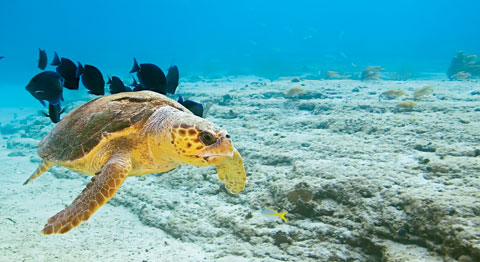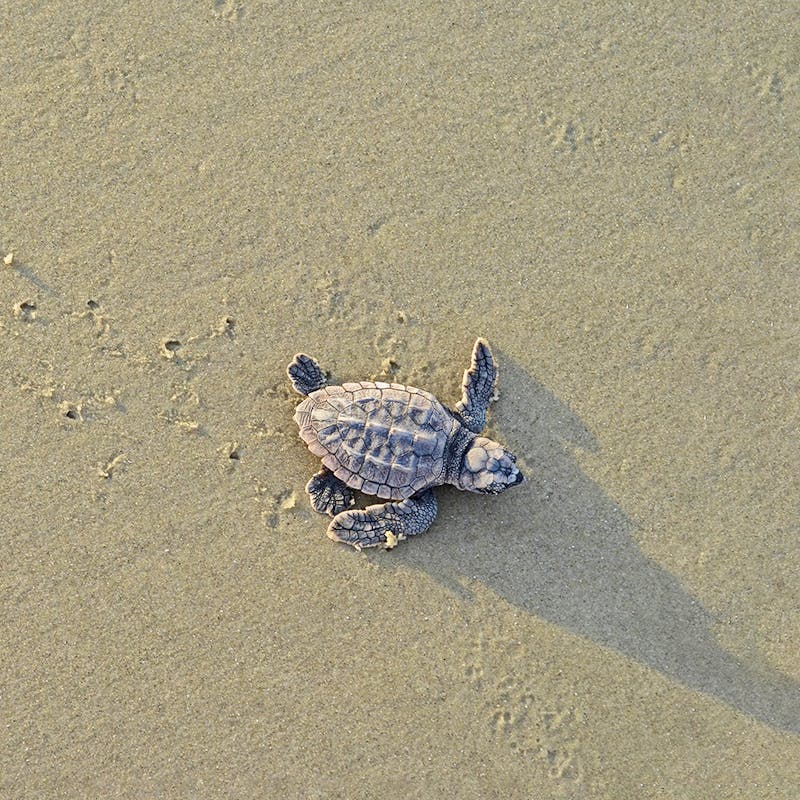Times are hard for sea turtles, but it’s not too late to save them
By Heidi Ridgley

The rising moon is at first mistaken for a ship’s light on the horizon, but there is no mistaking the solitary 300-pound sea turtle perched unevenly on a sand dune. Using her flippers to fling dirt several feet backward, this loggerhead is “pitting”— digging a nest—on a protected beach at Archie Carr National Wildlife Refuge on the central Atlantic Coast of Florida.
Named for the renowned biologist who first alerted the world to the plight of sea turtles in the 1950s, and the only national wildlife refuge in the country designated specifically to protect sea turtles’ nesting habitat, this refuge attracts more nesting—and federally threatened—loggerheads than any other place in the Western Hemisphere. More endangered green sea turtles lay their eggs here than any other place in the United States, and, to a lesser degree, endangered leatherbacks also nest on these shores.
In fact, these dunes lured nearly 19,000 nesting loggerheads last year, a recent record high. But these numbers are nowhere near historical levels, and the species—just like the green and leatherback—is still in trouble. Only about one in every 1,000 hatchlings lives to adulthood. Natural threats—from crabs to birds to sharks—abound. But sea turtles face their biggest threats from human causes, such as coastal development, global warming, oil spills, ocean pollution—particularly plastic bags—and accidental entanglement and drowning in commercial fishing nets and long lines. In some countries, turtles and their eggs are harvested for food.
Although homes along with family-run restaurants and hotels share the sand on some stretches, a lights-out ordinance requires everyone to keep the beach dark during nesting season from May to October. Artificial lighting confuses sea turtles, which can mistake the brightness for the reflection of the moon and the stars off the water.
If they head away from the sea, they risk death from dehydration or become food for predators or even roadkill. “Both the females and the hatchlings can get disoriented,” says Elizabeth Fleming, Defenders’ Florida representative, who works to preserve nesting and foraging areas and to improve coastal construction policies and practices. “In developed areas, it’s not uncommon for them to head beyond the dunes and sometimes even into parking lots and roads instead of back to the water.”
Ehrhart, who began studying nesting turtles on this beach before it became an official refuge in 1991, has his team of students from the University of Central Florida walk the beach every night to tally the eggs dropped, mark the new nests and measure and tag the turtles that turn up.
For the moment, we keep a safe distance as she digs. If we disturb her, we can cause a false crawl, and she will have wasted all her energy dragging herself up on the beach without depositing her eggs.
But once she’s in the nesting-turtle trance, I can stick my head right on the edge of the pit with the researchers as they count. “You’d have to just about light some fireworks and pound on her shell to perturb her now,” says Ehrhart. “Get right down there on your elbows,” he instructs.
Stretched flat on my stomach, head inches from her egg-laying end, I watch wide-eyed as little ping pong ball-like eggs drop two and three at a time. The pit is more than two feet deep so I don’t even see them land until they start to fill the hole. Biologist Ciro Amato sticks his hand in: “Let me get an egg real quick,” he says. Before I know it I am holding one, astonished. But the man who has been observing and recording this ritual for 31 years is still no less amazed by the eggs. “You’ll find I’m really hung up on them,” Ehrhart says.
Over the sound of the surf, he tells me how the egg helped reptiles evolve separately from their amphibian ancestors. “Reptiles could now go forth and conquer the great land masses of the Earth because the egg—with its enclosed life support system and porous shell—allows them to reproduce on land, something amphibians have never been able to do,” he says. “But this also became a liability.”
A female sea turtle spends 99.99 percent of her life in water, but to reproduce she has to crawl ashore using appendages adapted for swimming. “She doesn’t have the ability to scamper into the woods and hide her eggs under a stump,” he says. “Her only choice is to come out in one of the most dangerous places on Earth—an open beach—dangerous because of storms and tides and predators who can find the eggs easily. That’s why marine turtles lay many, many more eggs than any other turtles or other reptiles.”
But it’s not just the hatchlings that have it hard. Juvenile and adult sea turtles face a gauntlet of fishing gear as they make their way through the ocean—from longline fishing hooks that snag them to nets on shrimp trawlers. When caught—even though unintentionally—the sea turtles often get held underwater too long and they drown.
Defenders has long fought to protect sea turtles from such perils. In Mexico, Defenders successfully pushed for provisions in shark-fishing regulations to decrease sea turtle bycatch that included a ban on drift nets and all surface nets. “But since many Baja coastal fisheries use bottom-set longlines and gillnets, which invariably drown sea turtles, it has not been enough,” says Juan Carlos Cantu, Defenders’ Mexican program manager.
Cantu is also working with local and international organizations and research scientists to ensure Mexico’s Environment Ministry creates a refuge to protect loggerheads in their feeding grounds. “For the past five years, environmental authorities have dragged their feet on this issue, with never-ending stakeholder meetings that resulted in no protected area, and no regulation of the different types of coastal fisheries that are negatively impacting the loggerhead population,” says Cantu. “Last year, sadly, bycatch increased by 600 percent, making it the highest bycatch rate of loggerheads in the world.”
North of the border, Defenders filed suit in 2011 against the National Marine Fisheries Service (NMFS) in an attempt to stop the unprecedented numbers of sea turtles that were turning up dead on the beaches of the Gulf of Mexico and the southeast Atlantic Ocean. In that year alone, more than 3,500 dead sea turtles washed ashore.
After examining the bodies of some of these animals, NMFS linked the spike in deaths to drowning in shrimp-fishing nets. As part of a settlement with Defenders to resolve the case, NMFS agreed to examine expanding requirements for “turtle excluder devices,” known as TEDs.
Required in offshore federal waters, the sea turtle-saving devices—a grid of bars with an escape hatch in the fishing net that allows shrimp to pass into a bag at the end but turtles to get pushed out—are currently not required on skimmer trawls used in shallow waters. Instead, shrimpers must only limit their time in the water. But says Defenders’ senior attorney Sierra Weaver, evidence is mounting that these measures aren’t working to protect turtles. “Turtles that wash ashore represent only about 5 percent of those actually killed in shrimp nets, leading scientists to estimate thousands more die,” she says.
NMFS proposed expanding TED requirements last March, but decided in November that more study was needed before moving forward with the new regulations. “This is another case of political opposition causing the government to study an issue to death,” says Weaver. “We know that TEDs save turtles when they’re used properly. We also know that the offshore shrimp fleet has used TEDs for years without severe economic consequences. There is simply no good reason for the government failing to take action on this issue.”
At the same time, scientists are finding that global warming is making matters worse. The few nesting beaches that remain face flooding as ocean levels rise. And the temperature of the sand where sea turtles bury their eggs determines the sex of the hatchlings. Warmer temperatures produce females, cooler ones produce males. Rising temperatures throw the ratio of females to males out of balance, which could affect future breeding.
But back on the beach and oblivious to everything but the moment, the loggerhead we are watching spends the next 20 minutes covering and camouflaging her clutch, while Amato checks her for metal I.D. tags. Finding none, he adds one to each flipper. Biologist Ryan Chabot measures her girth and takes a skin sample for genetic testing.
Then following some final flipper flicks, just like her ancestors have done for the last 110 million years, with great effort she makes her way back to the waves that will bear her weight. “See you later,” Amato calls out, patting her carapace, causing its coating of blue-green algae to shimmer iridescently in the moonlight. She may return to the beach another time this summer, but after that she’ll be off to feeding grounds in the Bahamas, the Caribbean, the Florida Keys or Mexico. And if all goes well for her hatchlings, they’ll emerge in 45 to 60 days to scurry their way to the water.
When the sun rises tomorrow, I’ll be on the back of a three-wheeler with biologist Simona Ceriani reading the evidence in the sand: She’ll count the sea turtles that came ashore during the night, the false crawls—the tracks that make a U-turn back to the waves without pitting—the new nests, the nests where the hatchlings from eggs buried weeks ago clamored out, and the nests that didn’t make it—dug up by raccoons who left some of the broken eggs’ yellow remains.
But there’s one more thing left to do tonight. Three hatchlings, who were too exhausted to climb out of nests with their siblings the night before, get a second shot. After spending the day rehydrating, they are released in a spot where the next wave will reach as the tide goes out. I set one down that fits in half my palm and watch the surf sweep it sideways and deposit it back on the beach. The second wave sets it afloat, and with flippers flapping it joins the million-plus hatchlings that enter the ocean from this refuge each year.
Whether it survives to lay eggs on this beach or mate offshore decades from now is partly up to luck. But much of its fate—and that of all species of sea turtles—is determined by those who take action now to ensure the species survives into the future.
This is the second time DEFENDERS’ Editor Heidi Ridgley got the great privilege of touching a loggerhead’s nose while in the field with biologists reporting a story.
Only select articles from Defenders are available online. To receive 4 issues annually of the full award-winning magazine, become a member of Defenders of Wildlife!


